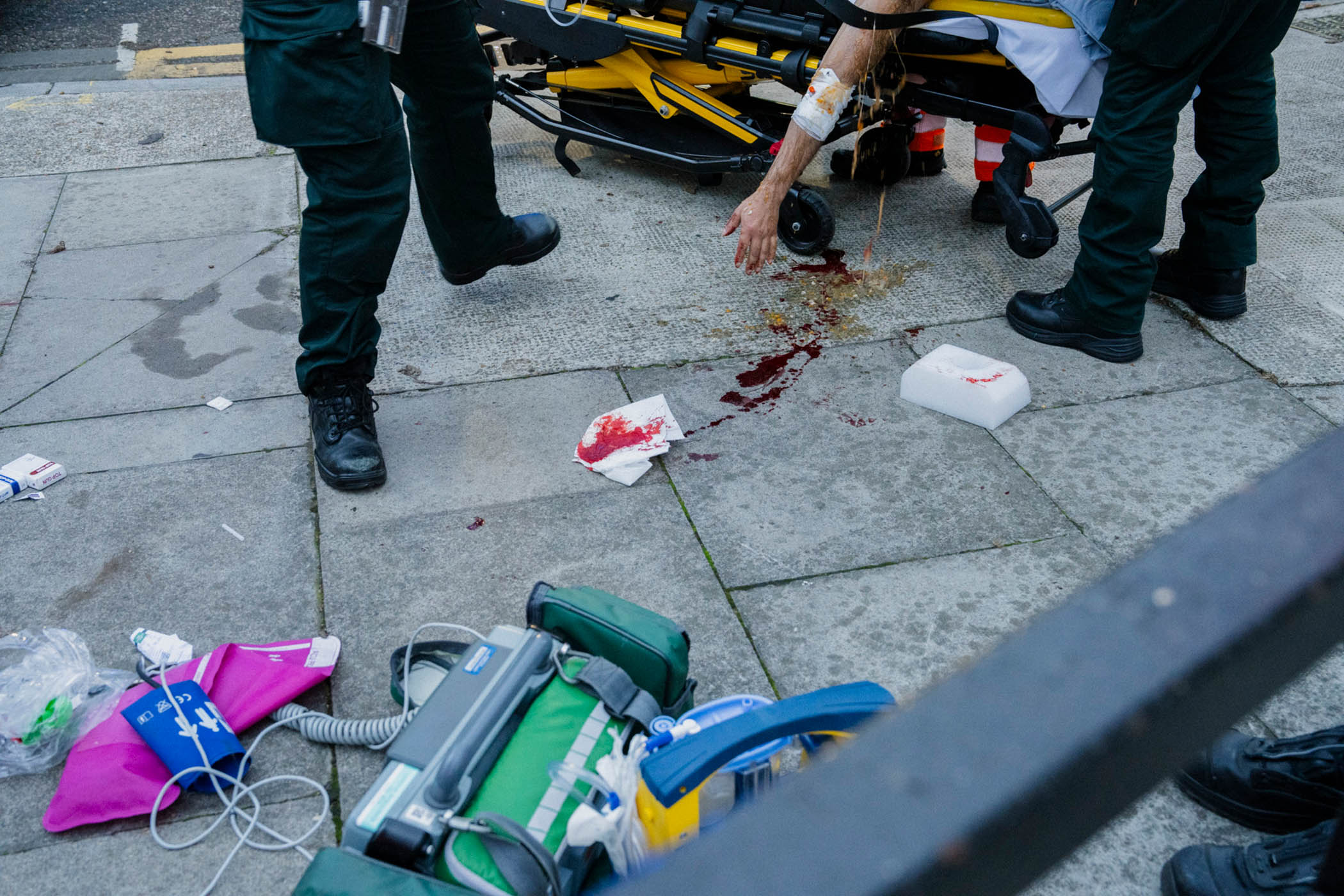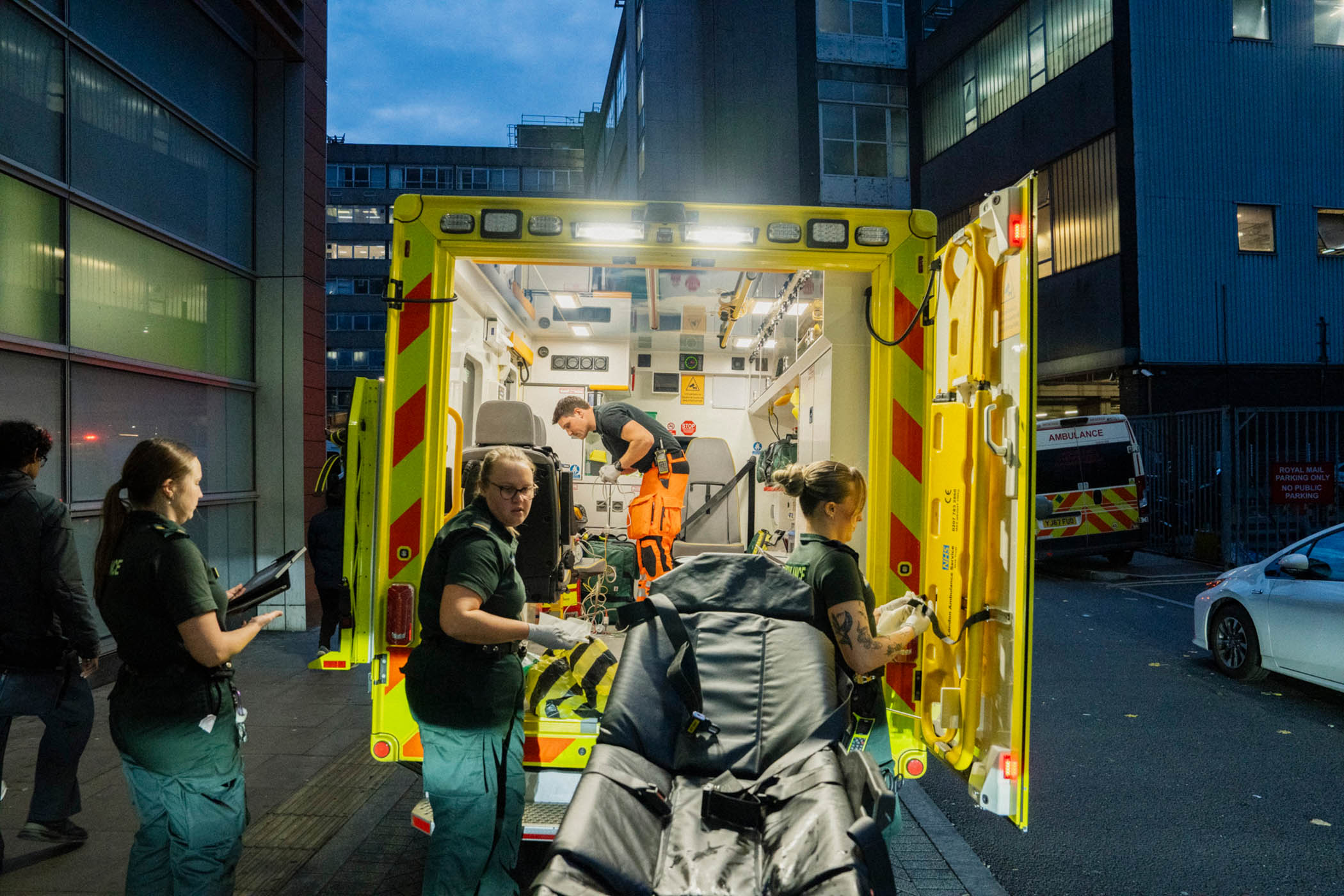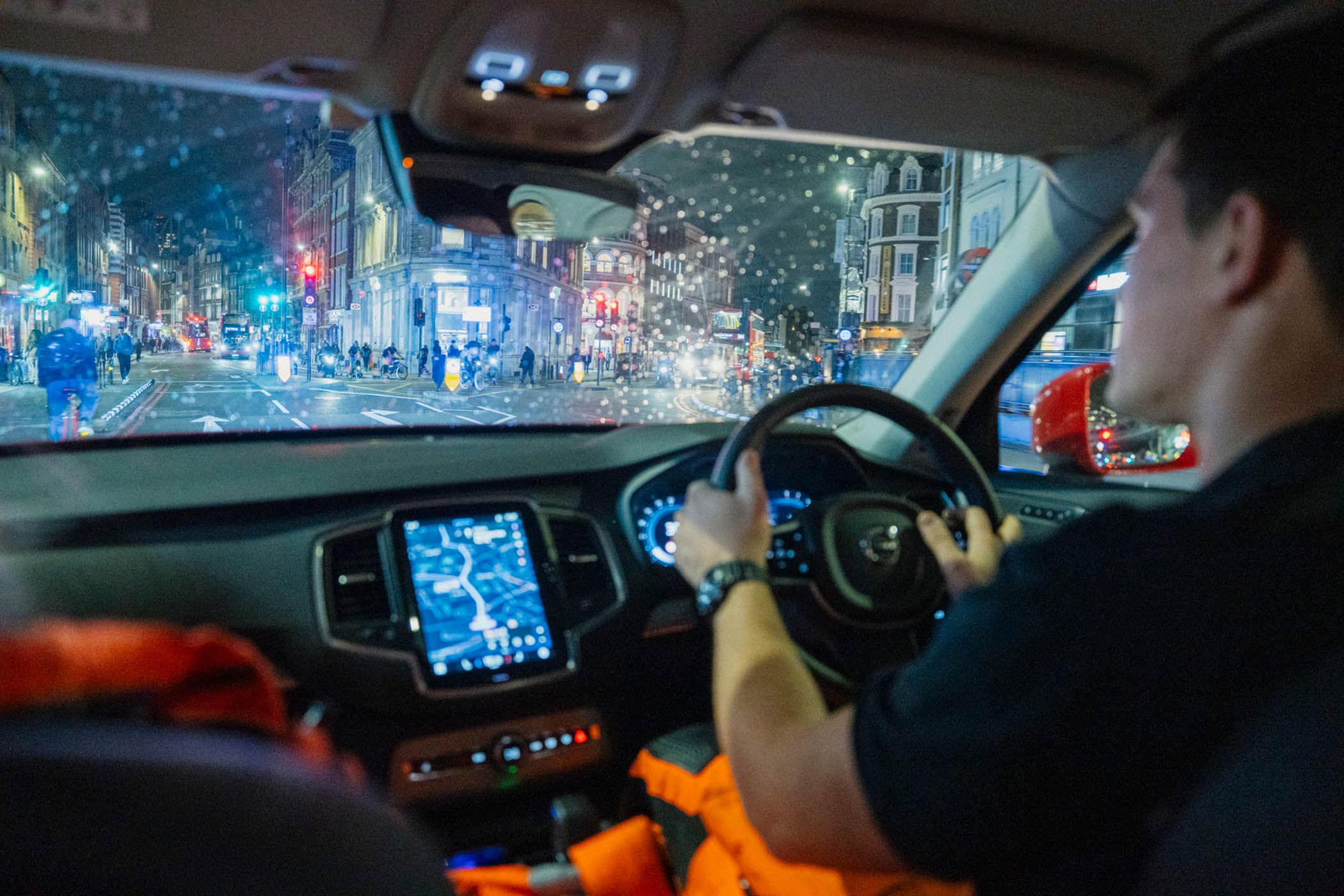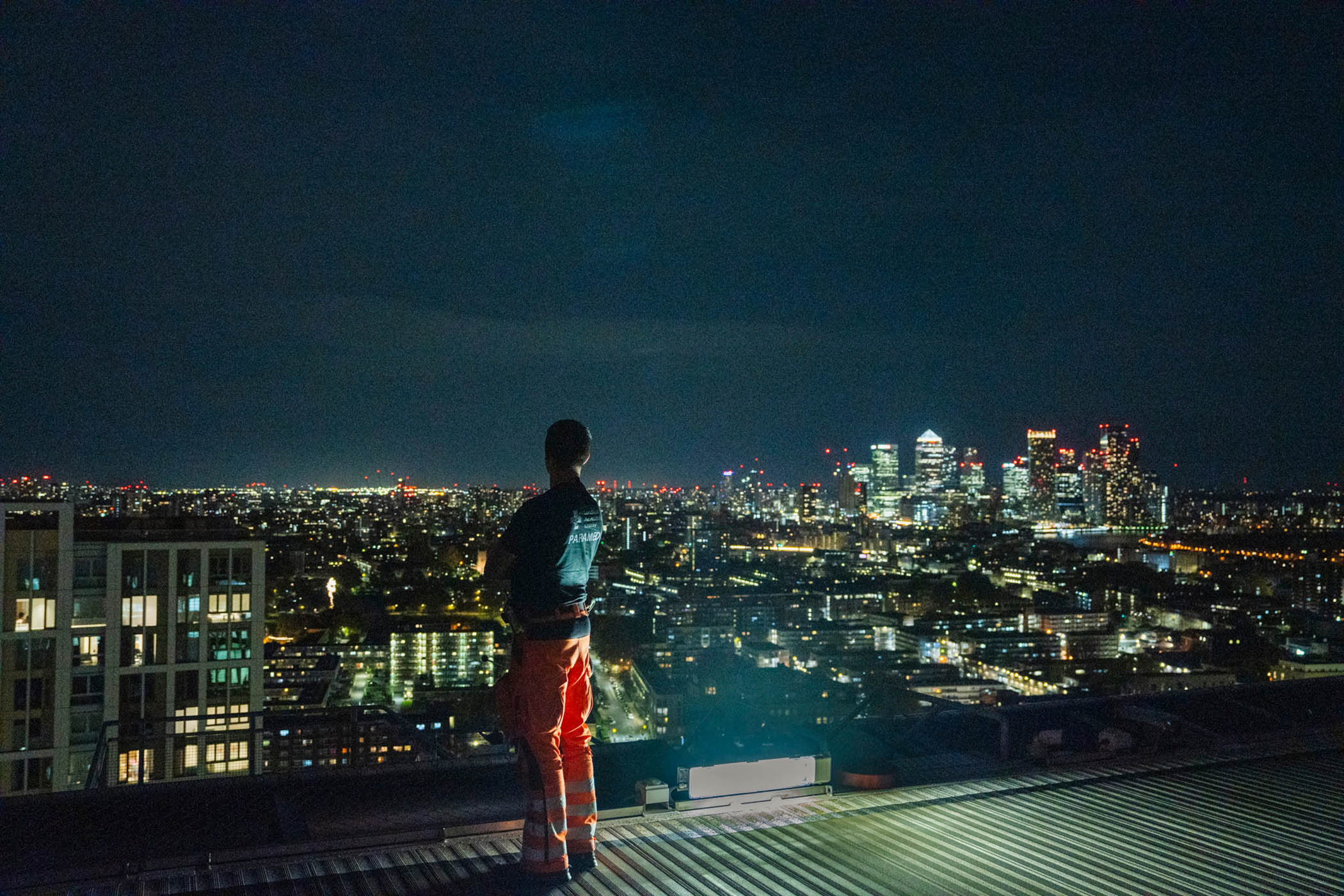Photographs by Harry Mitchell
London’s Air Ambulance (LAA) is a charity that works in tandem with the NHS’s London ambulance service, operating two helicopters and nine rapid-response cars. Unlike NHS frontline emergency crews, who attend everything from mental health crises to allergic reactions, LAA staff are reserved for the most critically injured Londoners: the people who may not make it to hospital. The idea is to bring the hospital to the patient – sometimes they conduct open-heart surgery by the roadside. Established in 1989, LAA has been present at every big London tragedy since then. Its emergency response teams deal in seconds, unlike consultants, who mostly deal in days. On Guy Fawkes Night, I was invited by LAA to shadow one of its emergency vehicles for a 10-hour shift. What follows is an account of those 10 hours. Identifying descriptions of patients and locations have been altered.
13.15
Arriving at the Royal London hospital in Whitechapel, we’re introduced to our team, consisting of one paramedic and one doctor, who’ll be dispatched in one of the charity’s Volvo XC90s. There are three operational teams: Medic 1, Medic 2 and Medic 3. We’re Medic 3. Today’s doctor is Flora Bird, an expert in brain injuries, who strikes me as caring and moral. The paramedic is Nick Baxter – also caring, but more brawny. Previously, Baxter had wanted to become a squaddie like his friends from school. I can imagine him competing on Gladiators. Bird used to work with the the Flying Doctors of East Africa (now Amref Health Africa), providing medical assistance in resource-limited settings, occasionally watched over by men with AK-47s. Both are in their early forties.
13.30
I’d initially asked to shadow the helicopter team, but there wasn’t enough space in the aircraft. Nonetheless, LAA staff bring me upstairs to see the view from the helipad. From up here, London doesn’t look real. The city is insatiable. Its people are all going about their day. Some of them will lose the great cosmic gamble and won’t see another; others will find their lives unalterably changed by random catastrophe.

The days begins on the helipad of the Royal London Hospital
13.45
Andy Frain, LAA’s senior public affairs manager, tells us what to expect. On average, each team responds to six calls every 24 hours. It’s imperative no one speaks when the blue lights are on so the driver stays focused. Last time Frain went out with the team, he found himself talking to a man who’d been shot point-blank in the chest with a nail gun. The patient’s last words before the injury were: “There’s no way you’re going to shoot me with that nail gun.”
13.50
We’re fitted with thick, steel-capped boots. Protective equipment is important. Not long ago, a paramedic was assisting a patient when he was pricked by a used needle and had to spend a week on post-exposure prophylaxis to reduce the risk of contracting HIV.
14.02
“Ultrasound pouch should have a tablet with battery at more than 50%”... “Check”... “Tablet in standby mode”... “Check”... “Ultrasound gel times five”... “One, two, three, four, five, check”... “Adult disposable oxygen tray”... “Check”... “Ear probe”... “Check”... “Wifi box that’s the same as the monitor and turned on”... “Check”... “Blood box sealed”... “Check”... “Transfusion pouch, sealed”... “Sealed, check”.
14.16
Bird speaks into her walkie-talkie. A voice mutters back. Medic 3 is now “green”. The team can be called at any time. Currently, LAA needs more blood, especially O-negative.
14.24
A klaxon sounds. Medic 1, the helicopter team, is being mobilised – house fire in west London: two patients, severe smoke inhalation. There may be a child. They don’t know any more than that. Staff don’t like to make assumptions. Bird says: “Assumptions make fools of us all.” In three minutes, the helicopter is in the air; 30 seconds later, it’s cleared the Leadenhall building and Bishopsgate.
14.47
We watch the aircraft disappear and Bird recalls a memory of her first significant emergency callout nine years ago. “My mouth was dry … a horse box had overturned and a lady in a car had been hit … she was very unwell, she had a brain injury … I remember seeing the horse box turned over in the ditch. It wasn’t raining – it wasn’t particularly sunny either. It was sort of mild.”
15.20
A group of students watch Bird demonstrate a Reboa (resuscitative endovascular balloon occlusion of the aorta). A Reboa is when doctors insert a balloon into your artery and inflate it to stop internal bleeding. It’s fiddly. The students practise on a mannequin whose face is fixed permanently with a weird euphoric smile. Bird makes groaning sounds and moves its limbs to simulate the chaos of the roadside.
15.43
The radio comes on. We’re up: head injury. Bird cuts the Reboa lesson short and runs towards the lifts with Baxter.
15.47
The ambulance lights come on and Baxter pulls out of the hospital. He’s one of the best drivers I’ve ever seen. I can hear him muttering to himself under the wail of the siren while Bird navigates. To pass the blue light driving course, students have to undergo a narration exam, reciting every detail of the road out loud in real time. They do this so instructors know what they’ve noticed. Baxter still narrates involuntarily. “Pedestrian right, cyclist left.” It’s like he’s in a kind of fugue state.
15.53
We arrive at a housing estate in east London. A crowd of onlookers have gathered outside their flats. The sky is beginning to darken.
15.54
The patient, a middle-aged man, is sprawled on the concrete with an oxygen mask jammed onto his mouth. There’s a half-empty bottle of Smirnoff next to him. The accident occurred, apparently, after some kind of altercation. Residents heard the thud of his head hitting the ground but no one I speak to saw what happened. There’s crusted blood on the patient’s face and hair. There’s also blood seeping across the pavement. “Hello, sir! What’s your name?” Bird asks, almost cheerfully. There’s no answer. Then his arm jerks up towards his face. His feet look small. It’s hard to tell if he’s drunk or dying – or both.

The blood and vomit of a middle-aged man with a head injury runs across the pavement
16.01
Various monitoring tubes and wires are attached to feet and fingers as he’s lifted on to a stretcher. He starts to groan, his head rolls, he groans again, wretches and vomits thin watery bile. Two elements, blood and vomit, coalesce beneath him. Bird pushes a vacuum into the patient’s mouth and he’s loaded into the ambulance.
16.09
I’m riding with him now, watching a paramedic hold his head still to mitigate bumps in the road. The monitor screen is making little mountains of his heartbeat, carbon dioxide (CO2) and oxygen levels. The oxygen appears like a canyon, the CO2 like an ocean. We’ll be at the hospital in six minutes. Bird is wondering whether the blood at the back of his head is collecting outside his brain tissue (good) or inside (bad). The patient appears to be shrinking.
16.11
Here, in the hermetic isolation of the ambulance, suspended between life and death, people change. They become like little children. Bird has worked with dozens of stab victims over the years. Almost all of them men – young men hardened by violence. Sometimes, as the vehicle carries them to hospital, they turn to Bird and their guard drops and there’s a short window of opportunity where she can hold their hand, tell them everything’s going to be OK. Then the back doors open and the hardness returns because they have to protect themselves.

After taking the patient to hospital, the team cleans the ambulance in preparation for the next call
16.24
Nurses and doctors are waiting for the patient in the trauma unit. He’s moved on to a bed and prepped for a CT scan. Bird fills out some paperwork and we leave him surrounded by blue overalls, his limbs moving like he’s in a bad dream.
16.52
Baxter has been attacked by patients before, he tells me. One man tried to hold two of his female colleagues captive in the back of the ambulance. Another chased him round a kitchen unit with a knife. Someone once threw their own shit at Bird but she managed to dodge it.
17.03
Another LAA team pulls up alongside us. It has just come from a house fire. Baxter and Bird roll the window down, shout across to its members. Everyone laughs.

Baxter narrates as he drives – a skill he had to master to pass the blue light driving course
17.10
There are jobs that linger more than others. Baxter has seen all manner of horrors, but the callout that really stuck with him happened early in his career, when he was mobilised to treat an elderly woman who wasn’t able to breathe. She looked “awful”. When her husband went upstairs to get a bag ready, she went into cardiac arrest, and by the time he came back down, it was too late. Baxter and his colleagues ended up in coroners’ courts. Baxter wasn’t fully prepared for the questions the bereaved family asked him. He felt like he’d let the patient down. Bird tries to reassure him. Her eyes were brown, he recalls of the deceased, deep brown.
17.16
“Sometimes, it feels like I’m on a movie set and everyone’s got a script except for me,” Bird says. “I remember the Croydon tram crash in 2016 and stepping over bodies. Glass everywhere. And I remember seeing this one patient surrounded by human chaos and destruction. And they were looking at me, fully alert in this chaos … you can’t write that chaos.” Seven passengers died that day. One was decapitated.
18.08
Another call comes through. Baxter floors it across Tower Bridge. London bends sideways.

Flora Bird, an expert in brain injuries, tends to a patient who has fallen off his motorbike
18.14
He’s come off his motorbike. Pedestrians gather, filming the scene on their phones. The patient’s been lying there for almost half an hour while the paramedics administer pain relief. One of his arms is fractured and loose like cooked spaghetti. His feet are crossed as if he’s been crucified. The patient calls out indistinctly. His good arm stretches up towards the sky. Is he pointing? The fireworks have begun overhead. There may be a spinal injury. Bird’s not sure yet.
18.17
“Why are you filming?” a policeman yells to a bystander. “Well, what are you doing with your phone then? ... All right – well, you can walk away, can’t you …”
18.19
“Excuse me,” a policeman asks Bird. “Is this life-threatening or is it life-changing?” She tells him that it’s not life-threatening. The patient may no longer be able to work. His arm will take years of therapy before it gets better – if it gets better.
18.40
A bus driver swears to the police that the accident wasn’t his fault. Terrible accidents are random by nature. They pick us off dispassionately and, if we survive, our existence is neatly divided into two parts: the before and the after. These accidents come like a wedge, forcing a gap in which Bird and Baxter operate like porters to another life.
18.45
Baxter is driving me to King’s College hospital in south London while Bird goes ahead in the ambulance with the patient. We talk about whether God exists. “I’m not against the idea,” he says. “Just, personally, I’ve seen so much crap.” A while ago Baxter attended an accident after a street race. Three or four cars were trying to outpace each when they lost control and struck an elderly couple who were on their way home from a night out dancing. Both suffered catastrophic injuries. One of them lost a limb. “And these kids were sitting on the side in police custody. They didn’t show any remorse. They weren’t happy, but they were smiling … that really hit me.” I think about how kids smile in groups when they’re ashamed.

Baxter, Bird and colleagues prepare to transfer the patient to hospital
19.00
King’s College hospital is one of the more chaotic trauma wards in the capital and tonight is a busy night. The patient is lying on a bed making low whimpering noises. An anaesthetist wanders in making little claw motions with his hands, miming syringes or possibly a crab. “Drugs?” he asks, nonchalantly, as if inquiring about a round at the pub. “Yep, give him some fun juice,” the doctor replies.
19.06
Another LAA team arrives with a gunshot victim. He’s been shot in the chest, but he’s still alive. He’s big. His eyes are closed and his mouth is scrunched in a look of grim determination. The patient is rushed inside and disappears into a flurry of care. Armed police follow him.
19.14
Despite official data showing murder rates declining, we’re often told that London is a lawless, dangerous place. Bird is from London and is continually witnessing the aftermath of violent crime. “We’re currently seeing a tragic epidemic of knife crime,” she says. “But, that aside, generally speaking, it’s very unlikely someone outside that ecosystem is injured in that way. But what I’d love you to include is that trauma happens to everybody; it is non-discriminatory – it could be any of us.” Bird is keen to stress that she loves London very deeply. Especially at night.
19.25
Paramedics and doctors like to use the euphemism “sick” when referring to patients. It’s the sort of word we use to describe a pupil taking a day off school. “Big sick” is deployed as a stand-in for: “Grievously injured, at serious risk of dying.”
19.50
Both Bird and Baxter have seen innumerable people die. We all have preconceptions about the moment of death: that people’s lives flash before their eyes, that they call out for their loved ones. “Some of the hardest questions to answer are the bravest,” she says. “I’ve had a number of patients ask me: ‘Am I going to die?’” Bird can’t lie to patients, so what’s the ethical response? She’s not sure. “Everybody’s answer will be different. So I try to offer reassurance about the fact that we are here and looking after you.” Patients who talk and then die, she says, are the hardest to deal with because they feel like they’ve “slipped from you”.
20.08
We’re eating chips and steak sandwiches at Mercato Metropolitano in Elephant and Castle. Bird and Baxter order food with trepidation; if a call comes in while their order’s being prepared, they’ll have to leave it behind, and might not eat for another couple of hours. This happens constantly. When the food comes, they start discussing the wonders of the human body, specifically our unpredictable relationship with pain. No one quite understands how pain works. We stub our toe and might feel more pain than the adrenaline-washed soldier limping one-legged to safety. As Abdul-Ghaaliq Lalkhen explores in his book An Anatomy of Pain (2021), pain sometimes only arrives after we realise the ramification of our injuries. You can see this in the athlete who only feels a fracture or muscular tear as pain when it dawns on them that their career is ruined. Children don’t cry when they’re really seriously injured; they go quiet. “It’s the quiet children you should be worried about,” Bird explains, remembering the quiet children she’s encountered on the job.
20.45
A few first aid tips: If there’s bleeding, apply pressure to the wound. If it’s a main artery, you’ll need lots of pressure. You can also use fabric as a tourniquet above the bleeding point. If they’re unconscious because of a head injury, open their airway. If they’re unconscious as a result of a stroke, open their airway and put them in the recovery position. The same goes for an overdose. If someone’s been stabbed, leave the knife in. But before any of that, call an ambulance.
He’s still alive. His eyes are closed and his mouth is scrunched in a look of grim determination. Armed police follow him
21.10
Baxter has a map of all the late-night spots in London. While the barista is preparing our flat whites, a call comes on Bird’s radio: a stabbing in Finsbury Park. Luckily, the other team is closer. The barista looks shocked at the incursion, then looks down at her feet.
21.22
Londoners are playing with explosives, firing rockets into the air. Two years before the 1605 gunpowder plot, several parishes of the City of London had begun continuously compiling weekly death statistics. One roundup from 1632 still survives today. Among others, 13 people are recorded to have died “planet stricken” – made incurably ill by the position of celestial bodies – 62 expired “suddenly”, 11 succumbed to grief and one fatality is listed as: “Bit [by] a mad dog.”
21.50
We’re in the control room at Vauxhall. Every emergency call in London passes through here. There are dozens of frantic operators. The noise swells and someone shouts for quiet. The news plays constantly on large screens in case there’s a large-scale incident. Staff have access to every Transport for London security camera in the city. Working with the Metropolitan police, they can access many others too. In front of me, Baxter helps an operator keep track of an ever-expanding, colour-coded list. It’s a list of every reported medical incident in London. Operators are expected to categorise them and dispatch teams if necessary. Every second, the list moves and grows with the flow of London’s suffering.
21.51
Male stuck in a ditch – Barnet. Fallen, hit head, bleeding – Wimbledon. Coughing up blood – Enfield. Sickle cell crisis – Blackheath. Discharged from hospital, refusing medical care, saying they want to die – Sutton. Taken cocaine – Holiday Inn, Brentford. Bitten by a black widow spider … Had chem sex, not with it – Battersea.
22.50
Someone passes me a headset and suddenly I’m listening in on a call. A little girl has hurt her leg but she’s breathing. The caller says they’ll stay with her until the ambulance arrives. The highest priority calls are labelled “Echo1”. This category of call means the two preliminary questions – “Are they breathing?” and “Are they aware?” – have both been answered no.
23.30
We’ve returned to the trauma unit to visit the first patient of the day, the man with the head injury and the Smirnoff bottle. He’s propped up against the bed, his pillow tinged with reddish brown stains. He’s alive. “Hello, sir?” Bird asks, “you OK?” He’s drowsy, asks for water and pain relief. “I need my phone,” he says. “Someone attacked me. I dodged them. I put them on the floor.” Bird tells him that he’s injured his skull. “Do you have a family?” she asks. He tells her he lives by himself. No one knows where his phone is.
23.45
The shift ends back on the helipad. To the east the towers of Canary Wharf glitter like a far off fairy kingdom, competing with their counterparts to the west in the City. All around us, fireworks are exploding into the night. I’ve never seen fireworks from above before. Londoners are celebrating their survival.
